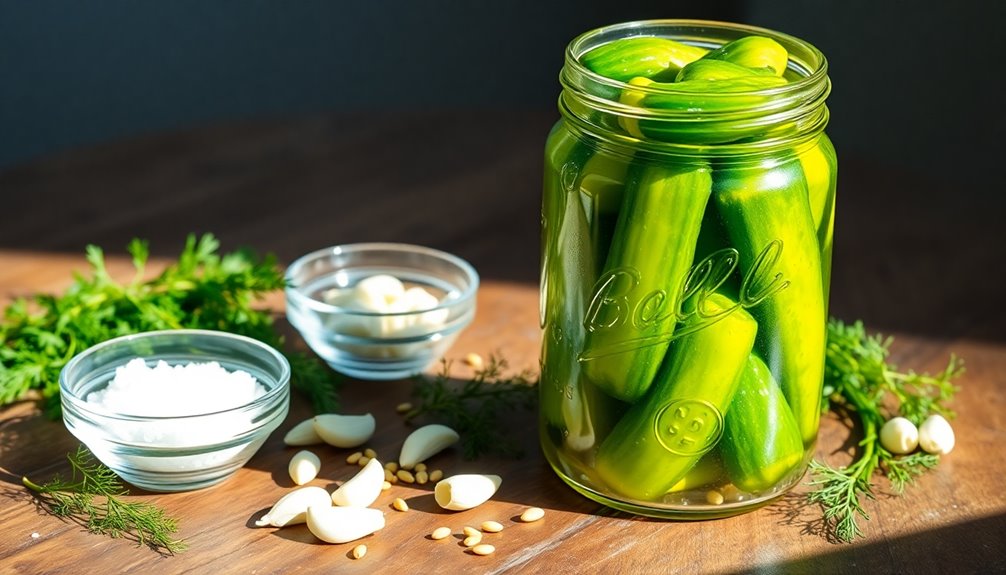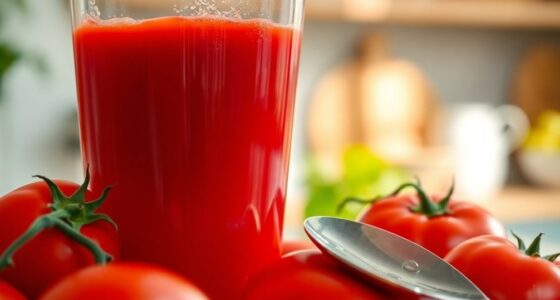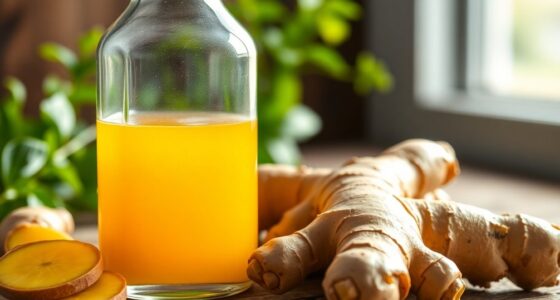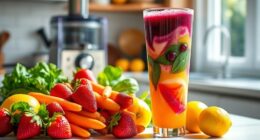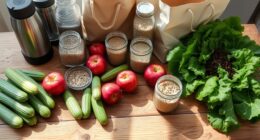To make homemade pickle juice, start by combining 2 cups of purified water with 1 cup of white vinegar in a saucepan. Add 2 tablespoons of kosher salt and 1 tablespoon of pickling spice. If you like, toss in a dash of sugar to balance the flavors. Heat the mixture over medium heat, stirring until the salt and sugar dissolve completely. Let it cool, and you'll be ready to pickle vegetables or explore other creative uses!
Key Takeaways
- Combine 2 cups of purified water and 1 cup of white vinegar in a medium saucepan.
- Stir in 2 tablespoons of kosher salt and 1 tablespoon of pickling spice.
- Optionally, add a dash of sugar to balance the tart flavor.
- Heat the mixture over medium heat until salt and sugar dissolve completely, then remove from heat.
- Allow to cool, then use immediately for pickling or store in the fridge for up to two months.
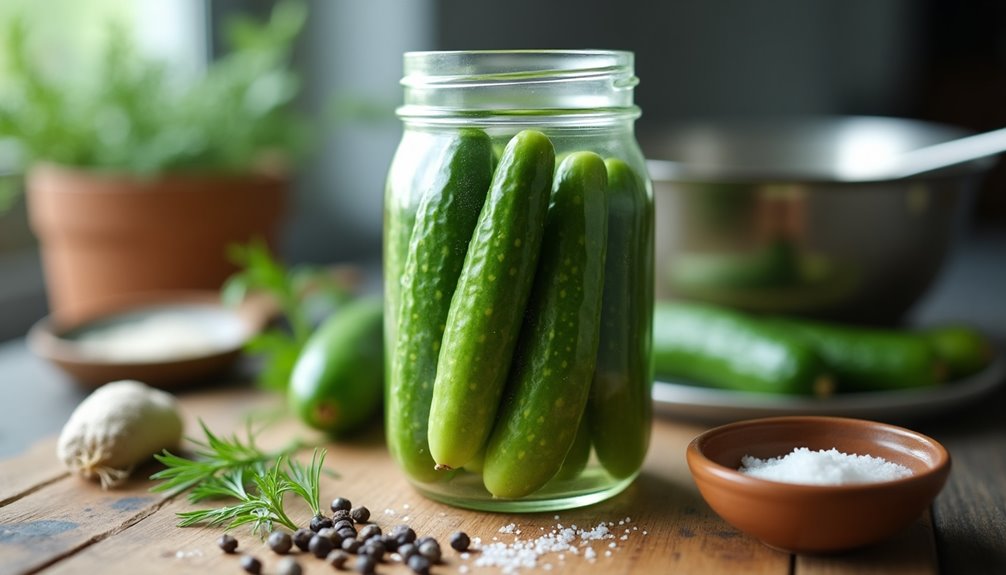
Pickle juice is a tangy and versatile brine that's easy to make at home. If you've ever enjoyed homemade pickles, you've likely tasted that delicious, zesty pickle juice that brings out the flavor of the vegetables. Making your own pickle juice not only allows you to control the ingredients but also opens up a world of creativity in the kitchen. You can use it for pickling a variety of vegetables or even as a health drink.
To start your pickle juice adventure, gather the necessary ingredients. You'll need 2 cups of purified water, 1 cup of white vinegar with at least 5% acidity, 2 tablespoons of kosher salt, and 1 tablespoon of pickling spice. If you're feeling adventurous, you might want to add a dash of sugar to balance the tartness of the vinegar. This little addition can really enhance the overall flavor of your pickle brine.
Now, grab a medium saucepan and combine those ingredients. Pour the purified water and white vinegar into the pan, then add the kosher salt and pickling spice. If you opted for sugar, sprinkle that in as well. Turn on the heat and warm the mixture over medium heat. Stir occasionally until the salt and sugar dissolve completely.
This is a crucial step because you want all those flavors to meld nicely. Once everything's dissolved, remove the saucepan from the heat and let the mixture cool to room temperature.
Once cooled, you can use your homemade pickle juice right away for pickling vegetables. Just pour it over your choice of veggies—cucumbers, carrots, or even red onions—and let them sit. The longer they sit, the more flavor they absorb.
If you're not using it immediately, you can store the pickle juice in the fridge. It'll keep well for up to two months, so you can always have this tangy treat on hand for your next culinary creation.
Beyond pickling, pickle juice has become a popular health drink. Many people believe it can relieve cramps and provide hydration because of its electrolyte content. So, if you're feeling a bit dehydrated or are recovering from a workout, sipping on some pickle juice might just do the trick.
Frequently Asked Questions
How Is Pickle Juice Made?
To make pickle juice, you start by mixing purified water, white vinegar, kosher salt, and pickling spice.
You can adjust the flavor by adding spices like garlic or red pepper flakes.
Heat the mixture in a saucepan until the salt dissolves, forming a brine.
Once combined, you can store it in the refrigerator for several weeks.
This tangy juice not only enhances pickles but may also help relieve muscle cramps due to its electrolytes.
How to Make Pickle Solution at Home?
To make a pickle solution at home, you'll combine equal parts water and vinegar, add some kosher salt, and mix in pickling spices.
You'll heat the mixture until the salt dissolves, then let it cool. Consider adding sugar for a balanced flavor.
Once it's ready, you can use it to pickle your favorite veggies or even enjoy it as a refreshing drink.
Just store it in the fridge, and it'll last for up to two months!
Can You Make Your Own Pickle Juice for Cramps?
Yes, you can make your own pickle juice for cramps! It's a great natural remedy due to its high electrolyte content.
Just mix water, vinegar, salt, and pickling spices, and you've got a quick solution. When you drink it, the acetic acid helps improve hydration and restore balance after exercise.
Plus, it's low-calorie and can even help with appetite control. Keep a batch in the fridge for easy access when cramps hit!
What's the Difference Between Pickle Juice and Pickle Brine?
Imagine diving into a tangy ocean of flavor!
Pickle juice and pickle brine might seem like twins, but they've got their differences. You'll find that pickle juice is the leftover liquid from pickles, often bursting with flavor and lower in salt.
In contrast, pickle brine is the fresh mix of vinegar, water, and spices used to create those crunchy delights.
Both can elevate your dishes, but each brings its own unique flair to the table!
Conclusion
Now that you've crafted your own pickle juice, you hold a tangy elixir in your hands, bursting with flavor and possibility. With its zesty kick, it's not just a brine; it's a culinary passport to new dishes and delightful drinks. Whether you're sipping it straight or using it to elevate your recipes, you've transformed simple ingredients into a vibrant concoction. So, embrace the tang, and let your taste buds dance in the briny bliss of your creation!
Cindy thoroughly researches juicing trends, techniques, and recipes to provide readers with practical advice and inspiration. Her writing style is accessible, engaging, and designed to make complex concepts easy to understand. Cindy’s dedication to promoting the advantages of juicing shines through her work, empowering readers to make positive changes in their lives through the simple act of juicing.

